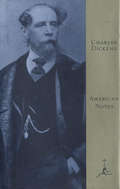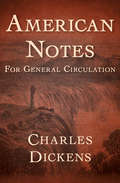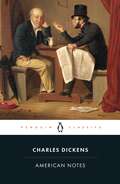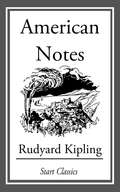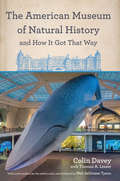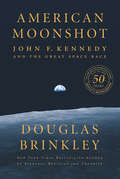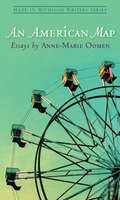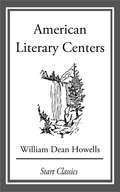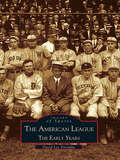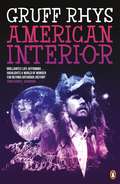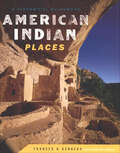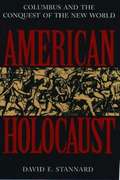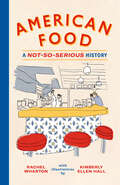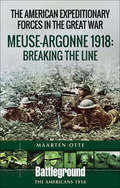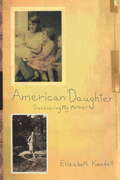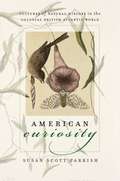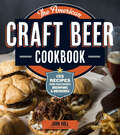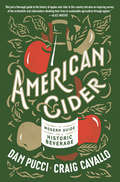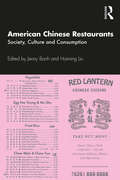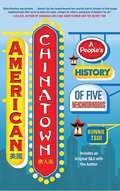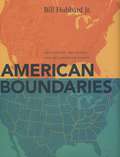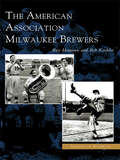- Table View
- List View
American Notes
by Charles DickensWhen Charles Dickens set out for America in 1842 he was the most famous man of his day to travel there - curious about the revolutionary new civilization that had captured the English imagination. His frank and often humorous descriptions cover everything from his comically wretched sea voyage to his sheer astonishment at the magnificence of the Niagara Falls, while he also visited hospitals, prisons and law courts and found them exemplary. But Dickens's opinion of America as a land ruled by money, partly built on slavery, with a corrupt press and unsavoury manners, provoked a hostile reaction on both sides of the Atlantic. American Notes is an illuminating account of a great writer's revelatory encounter with the New World.
American Notes: For General Circulation (Modern Library Series #Vol. 1)
by Charles DickensA travelogue detailing Charles Dickens's tour of North America In January of 1842, Charles Dickens and his wife, Kate, traveled from Liverpool to Boston. At the time, Dickens had already attained a tremendous level of literary success and fame, and the author hoped his travels would help him gain insight into the New World that had captivated the English imagination. Over the ensuing 6 months, Dickens explored the East Coast and Great Lakes regions of the United States and Canada, observing life on the opposite side of the Atlantic from a distinctly British viewpoint. By turns humorous, critical, witty, and incisive, this travelogue is a unique and keen look at 19th-century North America. This ebook has been professionally proofread to ensure accuracy and readability on all devices.
American Notes
by Charles Dickens'Like Shakespeare, Dickens was able to embrace a whole world' John MortimerWhen Charles Dickens set out for America in 1842, he was the most famous man of his day to make the journey, and embarked on his travels with an intense curiosity. His frank descriptions cover everything from his comically wretched sea voyage to his sheer astonishment at Niagara Falls, while he also visited hospitals, prisons and law courts. But Dickens's depiction of America as a land ruled by money, built on slavery, with a corrupt press and unsavoury manners, provoked a hostile reaction on both sides of the Atlantic. American Notes is an illuminating account of a great writer's revelatory encounter with the New World.Edited with an Introduction and Notes by Patricia Ingham
American Notes
by Rudyard KiplingIt is hardly fair to Mr. Kipling to call American Notes first impressions, for one reading them will readily see that the impressions are superficial, little thought being put upon the writing. They seem super-sarcastic, and would lead one to believe that Mr. Kipling is antagonistic to America in every respect. This, however, is not true. These Notes aroused much protest and severe criticism when they appeared in 1891, and are considered so far beneath Mr. Kipling's real work that they have been nearly suppressed and are rarely found in a list of his writings.
American Notes
by Rudyard KiplingThis is what Bret Harte has written of the great city of San Francisco, and for the past fortnight I have been wondering what made him do it. There is neither serenity nor indifference to be found in these parts; and evil would it be for the continents whose wardship were intrusted to so reckless a guardian. Behold me pitched neck-and-crop from twenty days of the high seas into the whirl of California, deprived of any guidance, and left to draw my own conclusions. <P> <P> Protect me from the wrath of an outraged community if these letters be ever read by American eyes San Francisco is a mad city--inhabited for the most part by perfectly insane people, whose women are of a remarkable beauty. .
The American Museum of Natural History and How It Got That Way: With a New Preface by the Author and a New Foreword by Neil deGrasse Tyson
by Colin DaveyThe American Museum of Natural History is one of New York City’s most beloved institutions, and one of the largest, most celebrated museums in the world. Since 1869, generations of New Yorkers and tourists of all ages have been educated and entertained here. Located across from Central Park, the sprawling structure, spanning four city blocks, is a fascinating conglomeration of many buildings of diverse architectural styles built over a period of 150 years. The first book to tell the history of the museum from the point of view of these buildings, including the planned Gilder Center, The American Museum of Natural History and How It Got That Way contextualizes them within New York and American history and the history of science. Part II, “The Heavens in the Attic,” is the first detailed history of the Hayden Planetarium, from the museum’s earliest astronomy exhibits, to Clyde Fisher and the original planetarium, to Neil deGrasse Tyson and the Rose Center for Earth and Space, and it features a photographic tour through the original Hayden Planetarium. Author Colin Davey spent much of his childhood literally and figuratively lost in the museum’s labyrinthine hallways. The museum grew in fits and starts according to the vicissitudes of backroom deals, personal agendas, two world wars, the Great Depression, and the Cold War. Chronicling its evolution―from the selection of a desolate, rocky, hilly, swampy site, known as Manhattan Square to the present day―the book includes some of the most important and colorful characters in the city’s history, including the notoriously corrupt and powerful “Boss” Tweed, “Father of New York City” Andrew Haswell Green, and twentieth-century powerbroker and master builder Robert Moses; museum presidents Morris K. Jesup, Henry Fairfield Osborn, and Ellen Futter; and American presidents, polar and African explorers, dinosaur hunters, and German rocket scientists. Richly illustrated with period photos, The American Museum of Natural History and How It Got That Way is based on deep archival research and interviews.
American Moonshot: John F. Kennedy and the Great Space Race
by Douglas BrinkleyAs the fiftieth anniversary of the first lunar landing approaches, the award winning historian and perennial New York Times bestselling author takes a fresh look at the space program, President John F. Kennedy’s inspiring challenge, and America’s race to the moon. <P><P>“We choose to go to the Moon in this decade and do the other things, not because they are easy, but because they are hard; because that goal will serve to organize and measure the best of our energies and skills, because that challenge is one that we are willing to accept, one we are unwilling to postpone, and one we intend to win.”—President John F. Kennedy <P><P>On May 25, 1961, JFK made an astonishing announcement: his goal of putting a man on the moon by the end of the decade. In this engrossing, fast-paced epic, Douglas Brinkley returns to the 1960s to recreate one of the most exciting and ambitious achievements in the history of humankind. <P><P>American Moonshot brings together the extraordinary political, cultural, and scientific factors that fueled the birth and development of NASA and the Mercury, Gemini and Apollo projects, which shot the United States to victory in the space race against the Soviet Union at the height of the Cold War. <P><P>Drawing on new primary source material and major interviews with many of the surviving figures who were key to America’s success, Brinkley brings this fascinating history to life as never before. <P><P>American Moonshot is a portrait of the brilliant men and women who made this giant leap possible, the technology that enabled us to propel men beyond earth’s orbit to the moon and return them safely, and the geopolitical tensions that spurred Kennedy to commit himself fully to this audacious dream. <P><P>Brinkley’s ensemble cast of New Frontier characters include rocketeer Wernher von Braun, astronaut John Glenn and space booster Lyndon Johnson. <P><P>A vivid and enthralling chronicle of one of the most thrilling, hopeful, and turbulent eras in the nation’s history, American Moonshot is an homage to scientific ingenuity, human curiosity, and the boundless American spirit. <P><b>A New York Times Bestseller</b>
An American Map: American Map (Made In Michigan Writers Ser.)
by Anne-Marie OomenMeditative travel essays by Michigan author Anne-Marie Oomen that explore new landscapes across America.
American Literary Centers: From 'Literature and Life'
by William Dean HowellsWilliam Dean Howells (March 1, 1837 - May 11, 1920) was an American realist author and literary critic... In 1858, he began to work at the Ohio State Journal where he wrote poetry, short stories, and also translated pieces from French, Spanish, and German. He avidly studied German and other languages and was greatly interested in Heinrich Heine. In 1860, he visited Boston and met with American writers James Thomas Fields, James Russell Lowell, Oliver Wendell Holmes, Nathaniel Hawthorne, Henry David Thoreau, and Ralph Waldo Emerson. Said to be rewarded for a biography of Abraham Lincoln used during the election of 1860, he gained a consulship in Venice. On Christmas Eve 1862, he married Elinor Mead at the American embassy in Paris. Upon returning to the U.S., he wrote for various magazines, including Atlantic Monthly and Harper's Magazine. From 1866, he became an assistant editor for the Atlantic Monthly and was made editor in 1871, remaining in the position until 1881. In 1869, he first met Mark Twain, which sparked a longtime friendship. Even more important for the development of his literary style--his advocacy of Realism--was his relationship with the journalist Jonathan Baxter Harrison, who in the 1870s wrote a series of articles for the Atlantic Monthly on the lives of ordinary Americans. He wrote his first novel, Their Wedding Journey, in 1872, but his literary reputation took off with the realist novel A Modern Instance, published in 1882, which described the decay of a marriage. His 1885 novel The Rise of Silas Lapham is perhaps his best known, describing the rise and fall of an American entrepreneur in the paint business. His socialviews were also strongly reflected in the novels Annie Kilburn (1888) and A Hazard of New Fortunes (1890). He was particularly outraged by the trials resulting from the Haymarket Riot
American League: The Early Years (Images of Sports)
by David Lee PorembaShowcasing two influential decades of home runs, stolen bases, and national heroes, David Lee Poremba invites us to take an in-depth look back through the history of baseball in The American League: The Early Years. Poremba has collected over 200 images and captions in this new volume that documents the fledgling American League and its charismatic teams, from its creation in 1901 to its lively rebirth as America's Pastime in 1920. Founded nearly a century ago when Western League President Ban Johnson renamed the circuit in 1900, the American League defied the norm. Amidst the struggles to name a National League president and the expiration of the National Agreement which governed the baseball world, Johnson leapt into open competition for players and fans. Seen in this extensive photographic collection are the historic players lured away from the National League and into the higher paying American League, including Ty Cobb, "Shoeless" Joe Jackson, "Wee" Willie Keeler, Cy Young, Nap Lajoie, and many others. With the introduction of the cork-centered baseball in 1910 and the advent of the Sultan of Swat, Babe Ruth, the game of baseball would change forever.
American Jewish Landmarks: A Travel Guide and History, Volume I
by Bernard Postal Lionel Koppman"American Jewish Landmarks" contains valuable historical data on all 50 states, Washington, D.C., Puerto Rico, and the Virgin Islands; and is required reading for people interested in the Jewish landmarks of the United States and her territorial possessions. It is also worth bearing in mind that this book is more than a manual for the tourist, it is an important book for students of American Jewish history.
American Interior: The Quixotic Journey of John Evans
by Gruff RhysAmerican Interior is a psychedelic historical travelogue from Welsh pop legend Gruff Rhys.In 1792, John Evans, a twenty-two-year-old farmhand from Snowdonia, Wales, travelled to America to discover whether there was indeed, as widely believed, a tribe of Welsh-speaking native Americans still walking the great plains. In 2012, Gruff Rhys set out on an 'investigative concert tour' in the footsteps of John Evans, with concerts in New Orleans, Baltimore, Philadelphia, Pittsburgh, Cincinnati, St Louis, North Dakota and more. American Interior is the story of these journeys. It is also an exploration of how wild fantasies interact with hard history and how myth-making can inspire humans to partake in crazy, vain pursuits of glory, including exploration, war and the creative arts. Gruff Rhys is known around the world for his work as a solo artist as well as singer and songwriter with Super Furry Animals and Neon Neon, and for his collaborations with Gorillaz, Dangermouse, Sparklehorse, Mogwai and Simian Mobile Disco amongst others. The latest album by Neon Neon, Praxis Makes Perfect, based on the life of radical Italian publisher Giangiacomo Feltrinelli, was recently performed as an immersive live concert with National Theatre Wales.
American Indian Places: A Historical Guidebook
by Frances H. Kennedy"This will become an indispensable guide to those special places that remind us that every place we think we 'discovered' was already someone else's home." --Ken Burns, filmmaker"A highly readable, extremely responsible and brilliant blend of guidebook entries and background essays by the most knowledgeable scholars and writers in the field of American Indian history and culture today. My earlier journeys sure would have been enriched with this wonderful book in the car. It opens up a brand new American experience for the adventuresome vacationer and armchair traveller alike." --Peter Nabokov, author of Where The Lightning Strikes: The Lives of American Indian Sacred Places "American Indian Places is an indispensable guidebook to all of us who share the ancient human landscape of this continent. These are the landmarks of the intertwined histories of American Indians and those who came later. Descriptions of 366 places, written by nearly as many authors, have been gathered together in this remarkable book, which holds special meaning for American Indians." --Dean R. Snow, president of the Society for American Archaeology"Anyone who is interested in the truly beautiful, distinctive, and spiritual places in this country will find this book all but indispensable. It is a precise and comprehensive guide to Native America, the definition of a landscape that is timeless and unique, above all an evocation of the sacred earth." --Scott Momaday, School for Advanced Research —
American Holocaust: The Conquest of the New World
by David E. StannardHow we destroyed more than one-hundred million of the earlier inhabitants of the New World.
American Food: A Not-So-Serious History
by Rachel WhartonAn illustrated journey through the lore and little-known history behind ambrosia, Ipswich clams, Buffalo hot wings, and more. This captivating and surprising tour of America’s culinary canon celebrates the variety, charm, and occasionally dubious lore of the foods we love to eat, as well as the under-sung heroes who made them. Every chapter, organized from A to Z, delves into the history of a classic dish or ingredient, most so common—like ketchup—that we take them for granted. These distinctly American foods, from Blueberries and Fortune Cookies to Pepperoni, Hot Wings, Shrimp and Grits, Queso, and yes, even Xanthan Gum, have rich and complex back stories that are often hidden in plain sight, lost to urban myth and misinformation. American Food: A Not-So-Serious History digs deep to tell the compelling tales of some of our most ordinary foods and what they say about who we are—and who, perhaps, we are becoming.
American Express Travel Guide to San Francisco and the Wine Regions
by Brian EadsA guide to the city of San Francisco and the surrounding regions.
The American Expeditionary Forces in the Great War: Meuse Argonne 1918: Breaking the Line (Battleground The Americans 1918)
by Maarten Otte&“An invaluable and extraordinary&” account of the bloodiest battle in American military history (Midwest Book Review). Although the Meuse-Argonne Offensive, which began in late September 1918 and continued through to the Armistice, was not the first major action fought by the AEF, it was the greatest in which it engaged in the Great War. The Argonne was an area that had been heavily fought over, particularly in the early part of the war; its eastern part, towards the Meuse, then became enveloped in the first great attritional battle of the war, Verdun. Maarten Otte gives a background narrative to events before the opening of the Offensive and its development. Taking each of the US corps in turn, he then provides tours that will help the visitor to understand the fighting and the problems that were faced. This opening book on the Meuse-Argonne takes the reader, more or less, to the date when General Pershing handed over command of the US First Army to Major General Liggard in mid-October, a change in command that marked a significant improvement in the American performance as they pushed the Germans ever backwards. The Great War battlefield of the Argonne is marked by numerous physical remains of the war, some fine (some might argue overly grandiose) monuments and by the stunning American cemetery at Romagne, the second largest in the world administered by the American Battle Monuments Commission. There is much to see in a battlefield that has been largely neglected in the decades since the Second World War.
American Daughter
by Elizabeth KendallIn this beautifully crafted book, Elizabeth Kendall tells the story of a family, of a passionate attachment between a mother and a daughter and the sudden tragedy that tears it apart. American Daughter is also a brilliant portrait of wellborn women's lives in cities and towns in the post-World War II era, as Kendall evokes how difficult it was to become anything other than an American daughter, which meant being a dependent woman. Occupying a coveted place in St. Louis's privileged high society, Henry and Betty Kendall seemed to be the American dream come true: six children, a sprawling house, a legacy of higher education at Harvard and Vassar. Yet underneath lay the flawed marriage of an idealistic young woman who made her eldest daughter her best friend and turned civil rights into her salvation. Elizabeth maintained the family silence as eccentricities began to appear in her father's behavior, along with whispers of financial difficulties. She accompanied her mother back to Vassar for a summer program on the home and family, then came into her own, away from her family, at the haven of a girls' summer camp and at Radcliffe. From the war-torn 1940s, when young men in uniform, home on leave, went to debutante parties, through the seismic social changes of the 1960s, Kendall tells the intertwined story of her mother and herself, of their powerful bond and how both shaped their lives in response to it. Unrelentingly honest, rich with humor and insights into families and women's lives, American Daughter is both a poignant portrait of American life at the middle of the twentieth century, and a dual coming-of-age story of a mother and a daughter, united by commitment and love, separated by a fatal accident-and by the vastly different birthrights of their generations.From the Hardcover edition.
American Curiosity
by Susan Scott ParrishColonial America presented a new world of natural curiosities for settlers as well as the London-based scientific community. In American Curiosity, Susan Scott Parrish examines how various peoples in the British colonies understood and represented the natural world around them from the late sixteenth century through the eighteenth. Parrish shows how scientific knowledge about America, rather than flowing strictly from metropole to colony, emerged from a horizontal exchange of information across the Atlantic.Delving into an understudied archive of letters, Parrish uncovers early descriptions of American natural phenomena as well as clues to how people in the colonies construed their own identities through the natural world. Although hierarchies of gender, class, institutional learning, place of birth or residence, and race persisted within the natural history community, the contributions of any participant were considered valuable as long as they supplied novel data or specimens from the American side of the Atlantic. Thus Anglo-American nonelites, women, Indians, and enslaved Africans all played crucial roles in gathering and relaying new information to Europe. Recognizing a significant tradition of nature writing and representation in North America well before the Transcendentalists, American Curiosity also enlarges our notions of the scientific Enlightenment by looking beyond European centers to find a socially inclusive American base to a true transatlantic expansion of knowledge.
The American Craft Beer Cookbook: 155 Recipes from Your Favorite Brewpubs and Breweries
by John HollOpen a cold one and get cooking! Showcasing the diverse ways that beer can be used to enhance a meal, either as an ingredient or by pairing, John Holl’s collection of 155 tasty recipes are designed for the beer-loving foodie. From twists on traditional favorites like American Wheat Bear Steamed Clams to unexpected surprises like Chocolate Jefferson Stout Cupcakes, you’ll soon be amazing your friends with the culinary versatility of your favorite beverage.
American Cider: A Modern Guide to a Historic Beverage
by Dan Pucci Craig Cavallo&“Not just a thorough guide to the history of apples and cider in this country but also an inspiring survey of the orchardists and cidermakers devoting their lives to sustainable agriculture through apples.&”—Alice Waters &“Pucci and Cavallo are thorough and enthusiastic chroniclers, who celebrate cider&’s pomologists and pioneers with infectious curiosity and passion.&”—Bianca Bosker, New York Times bestselling author of Cork Dork Cider today runs the gamut from sweet to dry, smooth to funky, made from apples and sometimes joined by other fruits—and even hopped like beer. In American Cider, aficionados Dan Pucci and Craig Cavallo give a new wave of consumers the tools to taste, talk about, and choose their ciders, along with stories of the many local heroes saving apple culture and producing new varieties. Like wine made from well-known grapes, ciders differ based on the apples they&’re made from and where and how those apples were grown. Combining the tasting tools of wine and beer, the authors illuminate the possibilities of this light, flavorful, naturally gluten-free beverage.And cider is more than just its taste—it&’s also historical, as the nation&’s first popular alcoholic beverage, made from apples brought across the Atlantic from England. Pucci and Cavallo use a region-by-region approach to illustrate how cider and the apples that make it came to be, from the well-known tale of Johnny Appleseed—which isn&’t quite what we thought—to the more surprising effects of industrial development and government policies that benefited white men. American Cider is a guide to enjoying cider, but even more so, it is a guide to being part of a community of consumers, farmers, and fermenters making the nation&’s oldest beverage its newest must-try drink.
American Chinese Restaurants: Society, Culture and Consumption
by Haiming Liu Jenny BanhWith case studies from the USA, Canada, Chile, and other countries in Latin America, American Chinese Restaurants examines the lived experiences of what it is like to work in a Chinese restaurant. The book provides ethnographic insights on small family businesses, struggling immigrant parents, and kids working, living, and growing up in an American Chinese restaurant. This is the first book based on personal histories to document and analyze the American Chinese restaurant world. New narratives by various international and American contributors have presented Chinese restaurants as dynamic agencies that raise questions on identity, ethnicity, transnationalism, industrialization, (post)modernity, assimilation, public and civic spheres, and socioeconomic differences. American Chinese Restaurants will be of interest to general readers, scholars, and college students from undergraduate to graduate level, who wish to know Chinese restaurant life and understand the relationship between food and society.
American Chinatown
by Bonnie TsuiCHINATOWN, U.S.A.: a state of mind, a world within a world, a neighborhood that exists in more cities than you might imagine. Every day, Americans find "something different" in Chinatown's narrow lanes and overflowing markets, tasting exotic delicacies from a world apart or bartering for a trinket on the street -- all without ever leaving the country. It's a place that's foreign yet familiar, by now quite well known on the Western cultural radar, but splitting the difference still gives many visitors to Chinatown the sense, above all, that things are not what they seem -- something everyone in popular culture, from Charlie Chan to Jack Nicholson, has been telling us for decades. And it's true that few visitors realize just how much goes on beneath the surface of this vibrant microcosm, a place with its own deeply felt history and stories of national cultural significance. But Chinatown is not a place that needs solving; it's a place that needs a more specific telling. In American Chinatown, acclaimed travel writer Bonnie Tsui takes an affectionate and attentive look at the neighborhood that has bewitched her since childhood, when she eagerly awaited her grandfather's return from the fortune-cookie factory. Tsui visits the country's four most famous Chinatowns -- San Francisco (the oldest), New York (the biggest), Los Angeles (the film icon), Honolulu (the crossroads) -- and makes her final, fascinating stop in Las Vegas (the newest; this Chinatown began as a mall); in her explorations, she focuses on the remarkable experiences of ordinary people, everyone from first-to fifth-generation Chinese Americans. American Chinatown breaks down the enigma of Chinatown by offering narrative glimpses: intriguing characters who reveal the realities and the unexpected details of Chinatown life that American audiences haven't heard. There are beauty queens, celebrity chefs, immigrant garment workers; there are high school kids who are changing inner-city life in San Francisco, Chinese extras who played key roles in 1940s Hollywood, new arrivals who go straight to dealer school in Las Vegas hoping to find their fortunes in their own vision of "gold mountain." Tsui's investigations run everywhere, from mom-and-pop fortune-cookie factories to the mall, leaving no stone unturned. By interweaving her personal impressions with the experiences of those living in these unique communities, Tsui beautifully captures their vivid stories, giving readers a deeper look into what "Chinatown" means to its inhabitants, what each community takes on from its American home, and what their experience means to America at large. For anyone who has ever wandered through Chinatown and wondered what it was all about, and for Americans wanting to understand the changing face of their own country, American Chinatown is an all-access pass.
American Boundaries: The Nation, The States, The Rectangular Survey
by Bill Hubbard Jr.For anyone who has looked at a map of the United States and wondered how Texas and Oklahoma got their Panhandles, or flown over the American heartland and marveled at the vast grid spreading out in all directions below, American Boundaries will yield a welcome treasure trove of insight. The first book to chart the country's growth using the boundary as a political and cultural focus, Bill Hubbard's masterly narrative begins by explaining how the original thirteen colonies organized their borders and decided that unsettled lands should be held in trust for the common benefit of the people. Hubbard goes on to show--with the help of photographs, diagrams, and hundreds of maps--how the notion evolved that unsettled land should be divided into rectangles and sold to individual farmers, and how this rectangular survey spread outward from its origins in Ohio, with surveyors drawing straight lines across the face of the continent. Mapping how each state came to have its current shape, and how the nation itself formed within its present borders, American Boundaries will provide historians, geographers, and general readers alike with the fascinating story behind those fifty distinctive jigsaw-puzzle pieces that together form the United States.
American Association Milwaukee Brewers, The (Images of Baseball)
by Bob Koehler Rex HamannMany people know of Milwaukee's famous beer brewers, such as Schlitz, Pabst, and Miller, but these pages contain the story of the original baseball Brewers. The Milwaukee Brewers of the American Association spent 51 seasons (1902-1952) on the city's near north side. To have had the opportunity to stretch out in the sun-soaked stands of Borchert Field during that era was to witness minor league baseball at its best. The Brewers were the second-winningest franchise in the league's history, and names like Tom "Sugar Boy" Dougherty and Nick "Tomato Face" Cullop were once household words throughout the city. This book stands as a tribute to the colorful history of this team and to all the former players, coaches, and managers who ever wore the woolens for Milwaukee.
